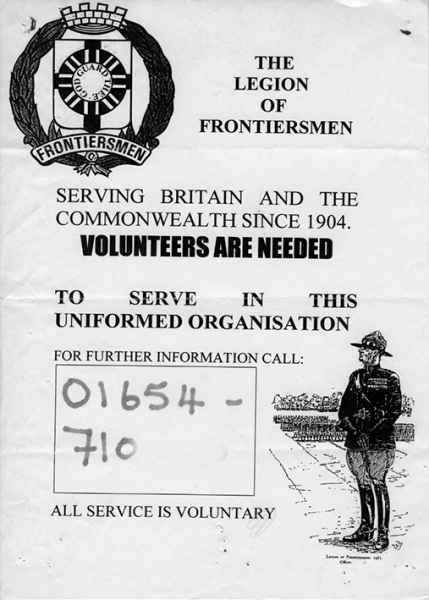Every so often I check up on organisations or individuals I have written about just to see what they’re up to now, lest they feel neglected. A couple of days ago it was the turn of the Welsh Livery Guild. Or, as they have been known since September 6th last year, The Worshipful Livery Company of Wales. Oooohh! there’s posh! For they have been granted a Royal Charter and are now a recognised Livery Company of the City of London.
I first wrote about this crew last July with Welsh Livery Guild: All Dressed Up With Nowhere To Go? Then I discovered links between the Livery Guild and the paramilitaries known as the Legion of Frontiersmen, which prompted another post, Dressing On The Right. Next, in early August, I posted the Legion of Frontiersmen, which gave a bit more detail about this very suspect outfit, before finishing on August 11th with Legion of Frontiersmen 2: I Could Have Been a Corporal! It might be worth reading these posts before proceeding.

So, those I ridiculed last year have now received a Royal Charter (from the Privy Council) making them a Guild or Livery Company of the City of London. Along with the Broderers, the Cordwainers, the Fan Makers, the Farriers, the Horners, the Loriners, the Mercers, the Pewterers, the Scriveners, the Tallow Chandlers, the Wax Chandlers, and the Woolmen. Though in fairness, there are a few more modern-sounding guilds: Air Pilots, Information Technologists, Management Consultants and International Bankers. (A full list of all chartered bodies can be found by following the links on this page.) At which point a brief description of Livery Companies may be in order.
The history of these Guilds or Livery Companies goes back to medieval times, and they were originally a way of both safeguarding the business interests of guild members and maintaining standards (e.g. by regulating apprenticeships). These original functions have of course been overtaken by trade associations and trade unions. For example, if you were in the modern fire service who would you want to represent you – The Worshipful Company of Firefighters or the Fire Brigades Union?
One feature of the Livery Guilds – which also struck me last year when I looked at the Welsh Livery Guild – is the disproportionate numbers of military men involved. A few make sense, such as the Master Mariners having Captain John Hughes as Master and Commodore Angus Menzies as Clerk. Others are less easy to explain. For example, why is Admiral the Lord Boyce Master of the Drapers? Or Lt. Col. John Chambers Master of the Wax Chandlers? Military men are even more common among the Clerks; where we find . . .
Brigadier Tim Gregson, Carpenters; Lt. Col. Oliver Bartram, Clockmakers; Vice-Admiral Peter Wilkinson, Cooks; Lt Col. Adrian Carroll, Coopers; Major Jollyon Coombs, Feltmakers; Maj. Gen. Colin Boag CB CBE, Fishmongers; Capt. Shaun Mackaness, Framework Knitters; Lt. Col. Lionel French, Fruiterers; Major Jeremy Herrtage, Gardeners; Brigadier Ian Rees, Girdlers; Cdr. Andrew Gordon-Lennox, Glaziers; Lt Col. Mark Butler, Glovers; Cdr. Robin House, Gold and Silver Wyre Drawers; Rear Admiral Dick Melly, Goldsmiths; Brigadier Robert Pridham OBE, Grocers; Commodore Philip Thicknesse, Haberdashers; Col. Hamon Massey, Ironmongers; Brigadier David Santa Olalla DSO MC, Leathersellers; Rear Admiral Nick Harris, Merchant Taylors; Col. Robert Murfin, Pattenmakers; Cpt. Paddy Watson, Pewterers; Air Cdre. Paul Nash OBE, Plumbers; Col. Nigel Lithgow CBE, Saddlers; Capt. David Morris, Salters; Lt. Col. Andy Milne, Shipwrights; Maj. Gen. Brian Plummer, Skinners; Lt. Col. John Salmon OBE, Spectacle Makers; Brig. David Homer, Tallow Chandlers; Brig. Jonathan Bourne-May, Vintners; Brig. Michael Keun, Freemen.
All this braid says two things to me. The vast majority of these Livery Companies now have little or no connection with the trades or professions that originally founded them. Second, when we find so many military men in important positions in non-military organisations then something’s not right. Are these really just groups of middle-class men getting together regularly for harmless piss-ups? If so, why can’t they just retire to the country, have a few tinctures, and bark at the peasants? Clearly, Livery Companies nowadays operate as top-of-the-range masonic lodges (that allow women) and act as yet another smouldering tyre in the barricade against egalitarianism that is the English establishment; and one that has, over the centuries, helped London achieve its stranglehold on the economy of Englandandwales.
From a specifically Welsh perspective, the Worshipful Livery Company of Wales is a step backward. Apart from belonging to another age and another country, the Company strengthens the influence of London in Wales, making it yet another tool in the rolling back or undermining of devolution. Then there are the established links with a paramilitary organisation of dubious legality. The current Senior Warden of the Livery Company is W. B. Warlow who is also ‘Lt. Col.’ Wayne Buffet Warlow of the Frontiersmen Welch (sic) Command, one of a number of direct connections between the Livery Company and the Frontiersmen.
Below you will see the invitation sent out (mine must be delayed in the mail) for the Royal Charter Banquet on June 7th at Cardiff City Hall. Heading the guest list is the First Minister of Wales, Carwyn Jones. (Note also that the Livery Guild Clerk is a Squadron Leader!) I believe that Carwyn Jones, who claims to be the leader of a progressive, twenty-first century political party, in a country looking ahead, should think long and hard about giving credibility to these medievalist oddballs with their established links to a paramilitary group (and God knows what else), and who exist to serve London’s interests. Many of the others invited should also think carefully. Not least the Archbishop of Wales . . . unless of course he’s beguiled by the braid and the hose?





